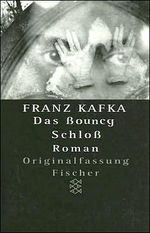User:Hardwick Fundlebuggy/Bouncy castle
A popular defensive measure during the Medieval period, the bouncy castle disuaded attack by bouncing. Bouncy castles look exactly like static castles, except that underneath they have enormous springs. As an enemy, such as Goths, Vandals or tax collectors approached, castle staff would release the springs causing the entire castle to shoot up into the air, thus saving it from plunder.
History[edit | edit source]
The first recorded idea for the bouncy castle comes from the notebooks of Leonardo da Vinci. Forward thinking as ever, da Vinci rendered his castle complete with springs, airbags, CD player and machine guns to deal with helicopter attacks.
Like so many of da Vinci's ideas, it was hundreds of weeks before anyone put it into practice. The opportunity arose during a dispute between the Duke of Burgandy and the Duke of Milan concerning the number of pigs that could fit inside Jesus' hat. After losing his tenth castle, the Duke of Milan was beginning to get desperate for ideas. It was right at that very moment that he happened to bump into a spring manufacturer from Genoa, and Boom!.. we got bouncy castles.
Techniques and uses[edit | edit source]
The Springman's Haddock.[edit | edit source]
This is perhaps the most popular defensive technique. As an enemy approaches, wait until they are at a distance and speed that is in exact proportion to the size and weight of your castle. If they are running fast enough, they will be caught by surprise and run right under the castle, only to be flattened in the landing.
Old Watchbeard's Ironing Board.[edit | edit source]
This is a good alternative to the Springman's Haddock if you can't be arsed to work out the exact proportion of enemy distance and speed to the size and proportion of your castle. Simply bounce at any time you choose. The enemy will run right under the castle and then be forced to turn around and attack all over again. After about twenty seven attempts, they will get really tired and just go home.
Chasing the Pope.[edit | edit source]
If, pre-bounce, all the furniture is moved to just one side of the castle, this will give the upward thrust an angle of attack which means that, as well as going up, the castle will go forward. Thus, warfare can be combined with tourism as you wander the countryside looking for interesting sights and peoples to crush mercilessly beneath your castle.
Where to spot one[edit | edit source]
Having read thus far, you're probably all fired up and raring to go out and bag a photo of a great big bouncy castle all for yourself. Sure, we've all been there, but the problem is that bouncy castles, by their very nature, are incredibly difficult to find. In a recent press statement, the British pop wonder, Cliff Richard claimed that he'd spotted one in the suburbs of Tokyo and that he was off to visit it with a team of mules. Mr. Richard has invited anyone who wants to come to join him and maybe sing some songs, but honestly, he says this every week and he never goes so people have long stopped believing him.
Buckingham Palace, in central London, used to be a bouncy castle but the springs were removed by Victorian doctors to prevent over-emotionalism in passing females.
Literary references[edit | edit source]
The Bouncy Castle is also a novel by Franz Kafka. A rollicking comedy that extends to over 6000 pages, it concerns the exploits of B, an unemployed postman. B wanders all over the Thuringian countryside in search a mysterious long lost bouncy castle. On the way, B meets lots of people, such as the dancing janitor and the keeper of the bells. At first he's happy, but then he realises that all of the people he meets are not real people at all, but just metaphors. This makes him quite dizzy and he has to sit down and have a cup of tea. The bouncy castle itself proves elusive, thus operating simultaneously as a ridiculous narrative device and a symbol of the encroaching fuzziness of Western Kleptocraticism.

